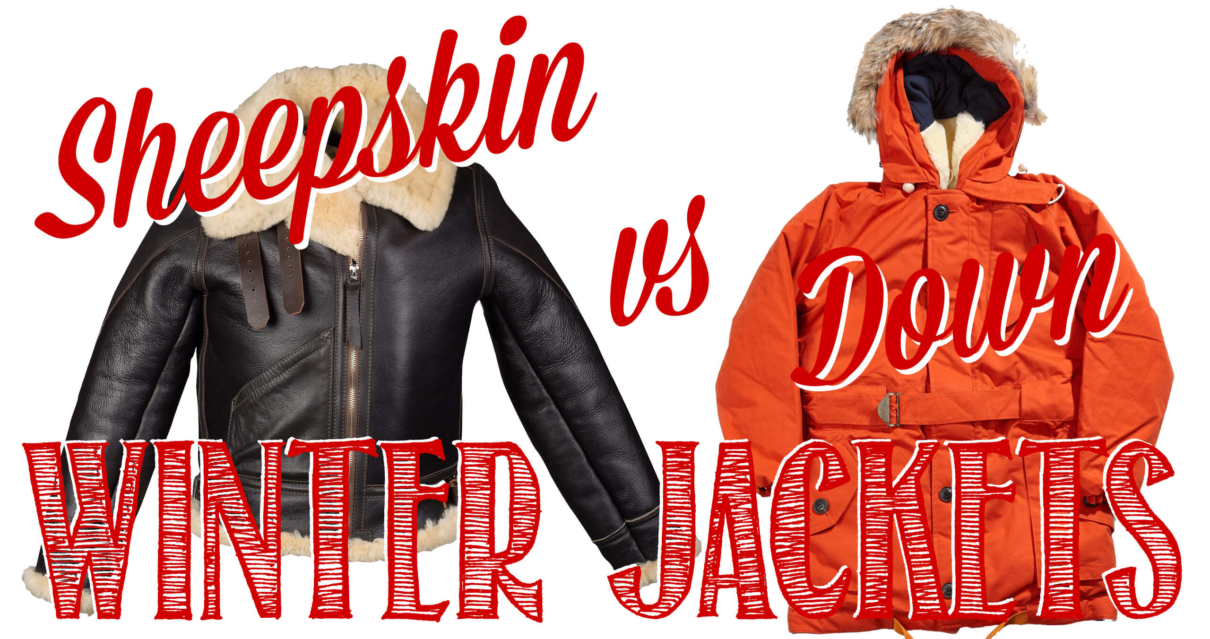6 points to help you decide between shearling or down for your next winter jacket.
In my opinion, once the temperature gets down bellow -5 we have 2 options. Sheepskin (shearling) jackets or down jackets. Both materials are amazing at keeping you warm. Both come in a variety of styles so you should be able to find something that works for you. And both have pros and cons.
Inspired by the weather here in Berlin right now (-16), let’s go through 6 points that will allow you to make an informed decision as to whether sheepskin or down is better for you.
How much does a jacket cost?
I always like to start with the cost, because how much you are willing to spend determines a lot about what will be the right choice for you.
I will start by saying that these things aint cheap. Bought new a good down jacket, using ethically sourced down filling will run you around $600 and it goes up sharply from there. If you want to be all fancy and French/Italian with Moncler you can be looking at a couple of grand and if you want something like the Nigel Cabourn Everest Parka, then your are looking at 3000 pounds.
For sheepskins, your base price is a little higher. For around 700 pounds you can get into the B3, B6 or D1… at least from my prefered leather jacket manufacturers, Simmons Bilt. Other brands are a little higher when getting to those models. Just like the down jackets, the prices can rise sharply. If you want a B6 from The Real Maccoys, then you are at $4000 quickly. The USA made Schotts are somewhere in the middle A B6 is about $1300.
Jacket style
This is a tricky one because it is entirely up to you. It will depend on what you like the look of and what fits with your look. At the moment the whole puffa/down jacket thing is quite “in”… and I don’t mean the Canada Goose thing of a couple of years ago. Thank god that’s behind us!
I am more meaning the whole North Face, Patagonia thing… A trickle down from the mountaineering vibe we’ve been seeing over the last couple of seasons. So if you go for the down jacket you might find yourself off-trend next season if that kinda thing is important for you.
Sheepskins are a bit more classic. Or at least they have not been “in” for so long that they are back to being a classic. They have their basis in the military and the majority of the models you will find out there are either direct repros or variations of the classics like the B3, B6 and the D1.
Therefore, they do carry this association with them and that military edge.
So, we’re back to the initial point. It’s what works for you.
Weight
Hands down the down jackets win. They are literally as light as a feather… All three of my down pieces are lighter than my single sheepskin. Sheepskin is a leather and even though it is on the lighter side as leathers go it is still quite weighty.
Durability. Just how long with the jacket last?
Again, tricky. It will depend on what the down jacket outer shell is made from. If it is made from something like thin nylon, one snag on a thorn could result in a nasty tear. There are other tougher materials but, if you rip through the outer shell then you could turn into a pigeon real quick, and all makes the jacket cosy could vanish in the wind.
The sheepskin will be more durable over the long haul. Leather is tough stuff and the wool is attached to the leather by the sheep itself, it grew the stuff after all and so it’s pretty solidly on attached. Even if you do rip right through it somehow the wool will stay attached and you just need to get your sewing kit out.
Leaving these extreme examples aside. I think that the sheepskin will look better for longer. Leather has that ability to get better with age and use. The day to day wear and tear actually adds to the aesthetics of the jacket. On the flip side, the nylon, polyester or even cotton used for the outer shell of down jackets could look a little shabby with extended wear.
Ethics and sustainability
Both down and sheepskin are of course animal products and both come with their own set of ethical issues to consider.
Ethics and sustainability of sheepskin
Let’s start with Sheepskin because here, there really isn’t any other way of getting it other than the death of the animal. It’s just like that. It is the sheep’s skin. But, no sheep is ever bread for its skin alone, the skin is a byproduct of the meat industry and in the vast majority of cases, the skins are destroyed. If the meat industry is an inevitability as of course, it is, then I would much rather see as much as possible of the animal going to good use.
There is then the subject of how the sheep were raised, how they were slaughtered and how their hides were tanned. I’ll be honest, the information out there is patchy at best, there doesn’t seem to be a universal seal of approval for sheepskins in the same way that there is for down. This is likly a reflection of the demand for the respective materials.
From what I’ve read a good rule of thumb seems to be this, if it doesn’t look natural and is still touted as sheepskin then it’s gone through some pretty harsh processes to make it look perfect. These perfect hides are produced on mass, cheaply and this is reflected in the sourcing of the animal hide. Think of the fluffy sheepskin rugs you get at IKEA compared to a Real McCoy’s B3.
Ethics and sustainability of down
Down is a little easier to really know you are making an ethical choice. It is quite well regulated and there are organizations in place that monitor and award ethical “stamps of approval” to suppliers. Which is a good thing because non-ethical down manufacture is a fucking horrible process.
Down is not feathers. It is like a mid-layer between the feathers and the bird’s skin. To get down these down feathers have to be removed. In the best cases when the animal is dead but cheaper down is taken from animals who are still alive. This is often done to birds that are already having a shitty time of it. Geese that are being bred for Foie gras or ducks for their meat.
Consumer choice driving change in fashion
Thank god, there are ethical choices and strict standards that suppliers and manufacturers have to adhere to if they want the label of “ethical down”. It is one of these cases where consumer choice is really driving change for the good in the fashion sector.
By far the most ethical way of attaining down is to steal it. That is, harvest it from the nests of geese. Don’t worry, these thieves are friendly and replace the down with straw to keep the eggs warm. Thing is. One nest nets you about 16g of down. A typical jacket takes about 300g of down… that’s a lot of nests. This gets expensive therefore not very common. Much more common is the harvesting of down from birds bred for the meat industry.
The responsible down standard would seem to be a very thorough and exact vetting process that down suppliers have to go through. Look for this logo. Or follow this link for more information on the responsible down standard.
The last aspect of ethics and sustainability comes down to the number and types of material used in the jacket manufacture. Down jackets need to be made of something, a material that contains the down filling. This can be, in theory, anything a lot of synthetic materials are used. As much as down is 100% biodegradable, the outer material may not be. It is something to consider.
A Sheepskin jacket is made of sheepskins. Throw that in the ground for a while and you will be left with a few lumps of metal from the hardware and possibly some thread if its polycotton.
Practicality
In a purely practical sense down wins. I don’t think there is any other material out there that has the equivalent insulation properties. It provides you with the greatest warmth for the least weight. Depending on the material used to make the jacket itself it can be pretty durable, can pack down to almost nothing and can allow total freedom of movement. I am told you can also just wash it in the machine. It’s just an all-round practical choice.
Sheepskin on the other hand is heavy. Takes quite a time to break in and soften up and with some styles, unless you size up a lot, you can forget reaching for anything over your head. Also, if it ever comes time to wash it, you will need to take it along to a specialist. It is plenty warm enough however and as we said before, is more durable and will age beautifully.
There is also the fact that sheepskin jackets are naturally water-resistant. From what I can tell, the materials used in down jackets seems to be more geared towards heat retention rather than water resistance… you seem to be needing an outer shell for that… hmm, upsell anyone?
From my personal experience, I prefer sheepskin over down in one way in particular. It seems to be more breathable and regulates heat better. When wearing my down jackets or gilets it is like the heat is actually being radiated into me. I get overly warm and sweaty. With the sheepskin, I maintain a more even temperature and the moisture seems to be wicked away much more efficiently than with the down jackets.
Up to you!
At the end of the day guys, it is a balance, there are no perfect garments out there. It is up to you to take into consideration a number of factors and make your decision based on your needs. Hopefully, when it comes to this subject at least. We have equipped you with a little more information for you to make the right choice of garment for yourself. One that will do the best job possible given your lifestyle and one you will enjoy for years to come.

